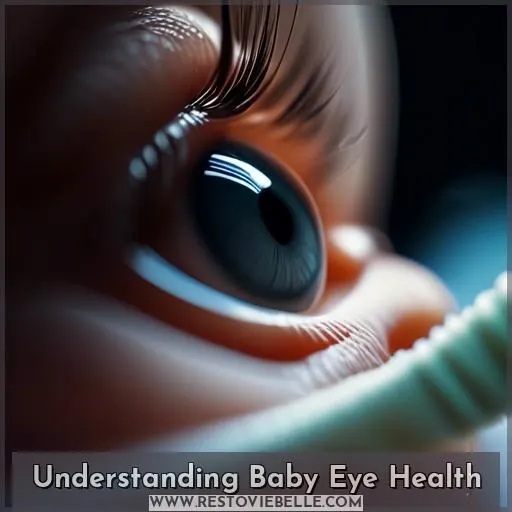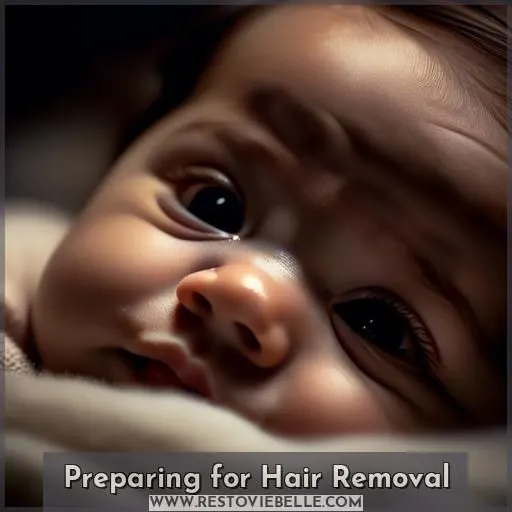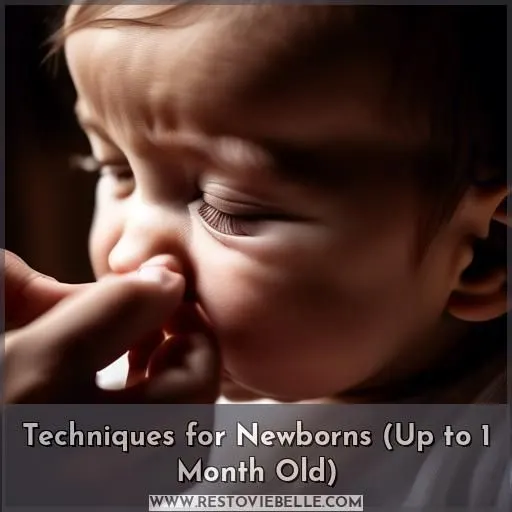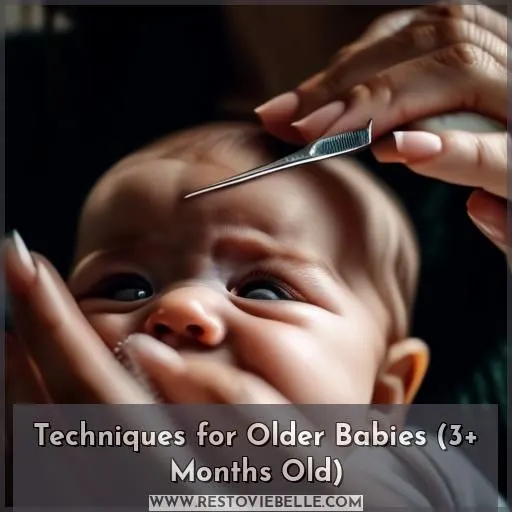This site is supported by our readers. We may earn a commission, at no cost to you, if you purchase through links.
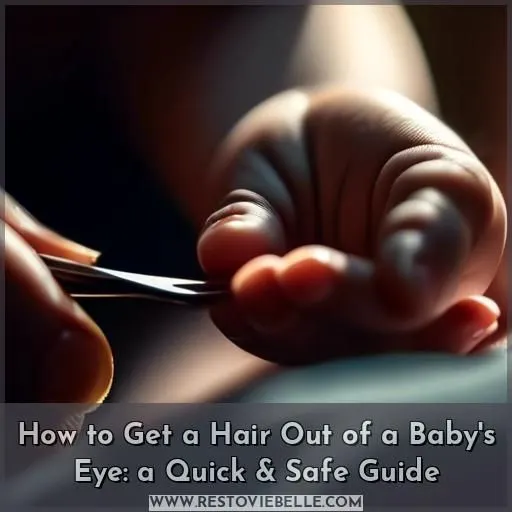
To get a hair out of your baby’s eye, first stay composed and gather the necessary supplies – sterile saline drops, soft cloths, and a towel. Gently encourage your baby to blink by touching their cheek or offering a distraction. Then, gently dab the area around the eye with a damp cloth, avoiding the eye itself.
If the hair remains, you can try flushing the eye with clean water and using sterile saline drops to comfort it. However, if symptoms persist or you notice any signs of infection, contact your pediatrician right away.
Taking the right precautions can help protect your baby’s eye health and comfort.
Table Of Contents
- Key Takeaways
- How to Get a Hair Out of a Babys Eye?
- Understanding Baby Eye Health
- Recognizing When to Seek Medical Attention
- Preparing for Hair Removal
- Techniques for Newborns (Up to 1 Month Old)
- Techniques for Older Babies (3+ Months Old)
- Aftercare and Monitoring
- Frequently Asked Questions (FAQs)
- Conclusion
Key Takeaways
- Stay composed and use sterile saline drops, soft cloths, and a towel to gently remove a hair from your baby’s eye, ensuring to encourage blinking and avoid direct contact with the eye itself.
- Understand the importance of baby eye health, including protecting their eyes from sunlight, maintaining cleanliness and hygiene, and observing for any signs of discomfort or irritation.
- Recognize when to seek medical attention, especially if symptoms like continuous tearing, refusal to open the eye, or signs of infection such as yellow or green pus are present.
- Prepare properly by washing hands, trimming fingernails, and gathering necessary materials before attempting to remove the hair, and always prioritize safety and gentleness during the process.
How to Get a Hair Out of a Babys Eye?
To remove a hair from a baby’s eye, gently use a wet finger or a damp tissue to brush the hair across the eye toward the ear. If the hair is deeply embedded, consider using a saline wash, but take care not to irritate the eye. If the hair is causing discomfort, seek professional help from a doctor.
Understanding Baby Eye Health
As a parent, you want to make sure your baby’s eyes are healthy and protected. Baby eye care is essential to prevent discomfort, corneal scratches, and infections. Here’s a quick and safe guide to understanding baby eye health:
- Babies’ eyes are fragile: Newborns have narrow nasal passages, and their eyes are prone to irritation.
- Shield from sunlight: Babies’ eyes are sensitive to UV rays, which can cause permanent damage. Use sunglasses with 100% UV protection, hats with wide brims, and find shade during peak hours.
- Cleaning and hygiene: Gently clean your baby’s eyes with warm water and a soft cloth, removing extra mucus and crust.
- Observe for discomfort: Watch for signs of irritation, such as tearing, blinking, or refusing to open the eye.
- Regular check-ups: Schedule regular eye exams with a pediatrician to monitor eye health and vision development.
Recognizing When to Seek Medical Attention
If your baby’s eye is causing ongoing discomfort or you can’t remove the hair, don’t hesitate to contact your pediatrician. Certain symptoms like tearing, vision changes, or pus indicate the need for immediate medical attention.
Symptoms Requiring Immediate Care
If you spot a hair or other foreign object in your baby’s eye, it’s crucial to determine when to seek prompt medical attention. Always seek advice from your pediatrician if you have concerns or suspect a sharp or high-velocity object has entered the eye.
Signs such as continuous tearing or blinking after cleaning, a child refusing to open their eye, a child sensing the object’s presence despite cleaning, or impaired vision post-cleaning may suggest a more severe problem.
Moreover, yellow or green pus, a serious symptom, warrants immediate medical attention.
Contacting Your Pediatrician
Regarding your infant’s ocular well-being, it’s imperative to ascertain the opportune moment to seek professional counsel.
Should you notice any symptoms requiring immediate attention, such as a foreign object lodged in the eye, persistent tearing or blinking despite washing, or signs of infection like yellow or green discharge, promptly contact your pediatrician.
They have the expertise to provide the necessary medical intervention and prevent the development of infections.
In the event of severe eye trauma, consider seeking immediate care at an emergency eye care facility.
Preparing for Hair Removal
Before trying to remove a hair from your baby’s eye, take necessary precautions.
Wash your hands thoroughly with soap and warm water.
Trim your fingernails to avoid scratching.
Gather the required materials like sterile saline eye drops, soft washcloths or cotton balls, and a towel.
Proper preparation helps create a safe and comfortable experience for your little one.
Safety Precautions
Regarding hair removal from your baby’s eye, safety is of utmost importance. Here are some safety measures to adhere to:
- Cleanliness: Wash your hands diligently before attempting to remove hair from your baby’s eye to mitigate the likelihood of introducing germs.
- Gentleness: Exercise care when removing hair to avoid causing distress or harm to your baby’s delicate eye.
- Patience: Take your time and avoid aggressive methods of hair removal to prevent injury or exacerbating irritation to your baby’s eye.
- Medical Attention: If you’re unable to remove the hair or if symptoms of infection, such as redness or swelling, manifest, seek medical attention for appropriate treatment and care.
- Prevention: Consider trimming your baby’s hair, particularly if it often comes into contact with their eyes, to minimize the risk of future occurrences. Keep their fingernails short so they don’t further scratch or damage the cornea when their eyes feel irritated. Maintain a clean environment for your baby, devoid of potential eye irritants, such as dust or pet dander, to ensure optimal eye health.
Necessary Materials
After ensuring safety, let’s gather your toolkit for this delicate mission.
You’ll need warm water, not too hot or cold, just like baby bear’s porridge.
Grab some cotton wool or a soft washcloth, gentle as a cloud.
Get a soft towel for drying those tiny adventurers.
Think of removing an eyelash from a baby’s eye as a stealth operation, where comfort and warmth lead the way.
This is how you master the art of baby eye care.
Techniques for Newborns (Up to 1 Month Old)
For newborns up to 1 month old, you’ll want to encourage natural blinking to dislodge the hair. If that doesn’t work, gently dab around the eye with a damp, soft cloth or cotton ball, being extremely careful not to touch the eye itself. The goal is to coax the hair out without causing further irritation.
Encouraging Natural Blinking
Essential for removing hair or debris from a baby’s eye is encouraging natural blinking. Here are four techniques:
- Sensory stimulation: Gently touch the baby’s eyelids or cheeks to stimulate the blinking reflex.
- Tear production: Use a warm washcloth to gently wipe around the eyes, stimulating tear production and natural blinking.
- Distraction: Sing a song or talk gently to distract the baby while you try to remove the hair or debris.
- Comfort: Offer comfort and let the baby cry if necessary, as this can help them relax and naturally blink more often.
Gentle Dabbing Method
When removing hair from a newborn’s eye, it’s essential to be gentle.
Avoid rubbing the eye, as this can irritate it.
Make sure the area is clean to prevent further discomfort.
If the baby is upset, calm them with soothing words or a lullaby.
If the hair remains, seek advice from your pediatrician.
Keep in mind, natural tears can help remove loose particles, so let your baby’s eyes do their job.
Techniques for Older Babies (3+ Months Old)
For older babies (3+ months old), gently flushing the affected eye with clean water is an effective method to dislodge any trapped hairs or debris. If the irritation persists, use sterile saline drops to further soothe the area and help remove any remaining particles. These techniques are safe, gentle, and often successful in resolving minor eye irritations in older infants.
Flushing With Clean Water
To safely remove hair from your baby’s eye, you can use the flushing technique with clean water. Here’s how:
- Choose the right temperature: Use lukewarm water, as hot water can cause burns to your baby’s delicate skin and damage the eye.
- Flush in the right direction: Tilt your baby’s head slightly to allow the water to flow over the affected eye and rinse out the hair.
- Protect their eye: Use a sterile syringe or clean dropper to make sure the water doesn’t enter the eye.
- Be gentle: Avoid using excessive pressure or sudden movements, as this could cause further irritation or injury.
Using Sterile Saline Drops
When it comes to using sterile saline drops for older babies (3+ months old), it’s crucial to adhere to specific guidelines to guarantee safety and effectiveness. Here’s a 4-point list to bear in mind:
- Composition: Confirm that the saline drops are sterile and free from any contaminants. Look for products specifically designed for baby use, as they’re more likely to be safe and gentle.
- Dosage Timing: Follow the manufacturer’s instructions for the appropriate dosage. Generally, for babies, 2 to 6 drops in each nostril may be recommended.
- Storage Safety: Store the saline drops in a cool, dry place, away from direct sunlight. Keep them out of reach of children to prevent accidental ingestion.
- Proper Disposal: Discard the saline drops after use, as they may contain bacteria that could cause infection if reused.
Alternative solutions, such as using a warm compress or gently massaging the tear duct, can also be considered if the baby is uncomfortable or the hair is deeply embedded. Remember, always consult with your pediatrician if you have any concerns about your baby’s eye health.
Aftercare and Monitoring
After successfully removing the hair from your baby’s eye, it’s essential to watch for any signs of discomfort or ongoing irritation. Make an appointment with your pediatrician to make sure your baby’s eye health is good and to discuss any concerns you may still have.
Monitoring for Discomfort or Irritation
After you’ve tackled the hairy situation, keep a watchful eye for any signs of irritation.
If your little one’s rubbing their peepers or the waterworks start without a peep, it could signal discomfort.
Redness or swelling are red flags that the eye’s still in a pickle.
So, stay alert, and if those baby blues aren’t looking so peachy, it’s time to call the doctor.
Regular Eye Health Check-ups
Regular eye health check-ups are essential for ensuring your baby’s eye development is on track.
These visits can help prevent eye infections, detect any potential issues early, and provide guidance on sun protection for their eyes.
Vision screening guidelines recommend regular check-ups starting at birth.
The first thorough eye exam is typically scheduled between 6 and 12 months.
By prioritizing these appointments, you’ll be taking proactive steps to safeguard your baby’s vision and overall eye health.
Frequently Asked Questions (FAQs)
Can I use a Q-tip to remove hair from my babys eye?
Ouch, it’s understandable to be concerned when your child has a hair in their eye! While cotton swabs may appear tempting, it’s advisable to refrain from inserting anything into the eye. Instead, gently rinse with clean water and consult with the pediatrician if the irritation continues.
Is it safe to use breastmilk to flush hair out of a babys eye?
Using breastmilk is generally safe to flush out a baby’s eye, but it’s best to avoid trying this yourself. Seek your pediatrician’s advice – they’ll know the gentlest approach for your little one.
How can I tell if a hair in my babys eye is causing irritation?
Is your baby’s eye red, teary, or sensitive to light? If so, that hair is likely causing irritation. Gently flush the eye with clean water and see if the discomfort subsides. If not, contact your pediatrician right away.
Can I use a syringe to flush hair out of my babys eye?
No, don’t use a syringe – that could hurt your baby’s delicate eye. Gently flush the eye with clean water or use sterile saline drops. If the hair won’t come out, see your pediatrician.
Is it necessary to seek medical attention for a hair in my babys eye?
Definitely seek medical help if that pesky hair won’t budge – your little one’s eyes are precious, and you don’t want to take any chances. The doc can quickly and safely remove it.
Conclusion
According to the American Academy of Ophthalmology, nearly 70% of eye injuries in children occur at home. By following the safe and effective techniques outlined in this guide, you can quickly and gently remove a hair from your baby’s eye and prevent potential complications.

